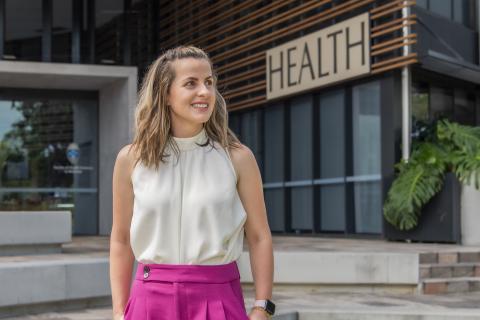
The study of human anatomy is notoriously challenging for students of health sciences – it’s akin to learning a whole new language to name, locate and understand the structures that make our bodies function.
But Assistant Professor of Medicine Nicolene Lottering’s use of new technology to engage her students and make taking anatomy easy, rewarding and even fun, has won her a prestigious international teaching award.
Dr Lottering has been awarded the Grand Prize in the Anatomy and Physiology category in the Osmosis Raise the Line Faculty Awards.
This is the first year Osmosis, the online health education platform by Elsevier, has featured an Anatomy Educator category. The annual awards attract nominations from across the globe, and Dr Lottering was nominated by those she has taught at institutions across three states – here at Bond, in South Australia and Victoria.
Dr Lottering said she was thrilled to know her teaching had positively impacted so many students.
“It’s particularly nice to hear that the impact I have been able to have as an educator has been long lasting and that some of the nominations came from students that I had taught several years ago,” she said.
“As someone who is passionate about giving students the best possible learning experience in what can be a challenging subject, knowing that this nomination came directly from students is such a thrill. I am a big believer of ‘working with’ and ‘learning with’ students through co-creation, and it has been inspiring to see students carry their anatomy knowledge into their respective degrees and professional pathways.”
The Osmosis Awards received more than 1000 nominations covering 375 institutions globally. Dr Lottering was the only Australian Grand Prize winner and one of just two Australian educators shortlisted. Bond University colleague, Associate Professor Christian Moro, also received a finalist award in Physiology.
The awards recognise the work of health educators who are helping to ‘raise the line’ by increasing the healthcare capacity around the world.
Dr Lottering is passionate about technology-enhanced learning and has worked hard at several Australian universities to implement virtual reality, imaging anatomy (using patient medical imaging scans), and is the first anatomist to introduce the lightboard for medical videos.
During the pandemic, in Victoria’s lockdown, she hosted anatomy drawing tutorials over Zoom, which built a sense of community, with students telling her they found the drop-in drawing sessions ‘therapeutic’ during times of isolation.
And it’s not just Bondies benefitting from her fresh approach to teaching what can be difficult and dense content. She employs technology, film, social media, drawing, storytelling and medical case studies not only in the classroom but on her YouTube channel which boasts almost 8,000 subscribers and had 57,500 new views in 2022 from students across Australia, the United States and India.
Her goal is to embrace young learners’ love of all things digital and, as a tech-savvy anatomist, provide a vibrant learning community using creative approaches that suit the way modern students learn best.
Dr Lottering’s ‘lifelong obsession with bones’ was inspired by seeing the stories bodies can unveil about how a person lived, or who they are, even long after death, on television shows like Bones and NCIS where female characters solved crimes with science.
‘If you can see it, you can be it’ is a phrase that that has inspired Dr Lottering to be a staunch advocate for encouraging more girls into STEM - Science, Technology, Engineering and Maths – pursuits from an early age.
“It’s why I’m passionate about working with young children, especially girls, to help them develop a love of and confidence in STEM subjects,” she said.
She also supervises higher degree research students in Forensic science, seeing mentoring as an important role for all woman in science and medicine.